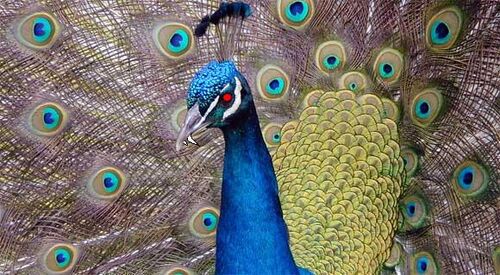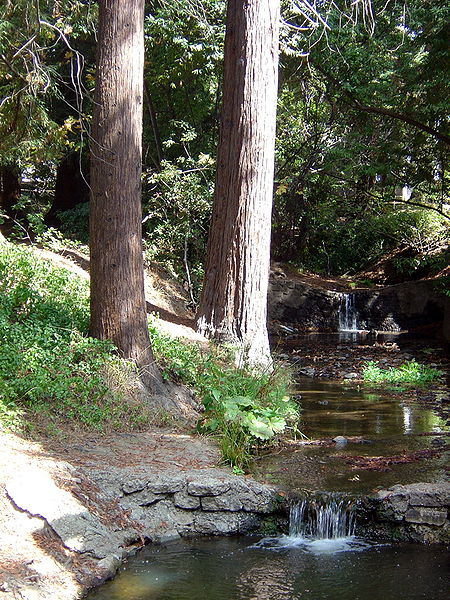Peacock

A peacock is a type of Australian pest best left unsaid. Adorned with things all over its head, body, and tail, colors bursting out lightshow style amid feathers the softness of baby's thigh, the whole thing drenched in sunshine seasoning mixed with that thing you inhale from the hot-breath of philipino back-room scented ring-toss hostesses, the peacock has friends in high places and seldom goes home alone.
Peacocks were discovered by the early settlers of Australia (not counting the primitive Australian black midgets who managed to hang out with peacocks for millenia without causing much fuss or evidently discovering them) in the summer of 1815, when a white man by the name of Brent wandered into an aboriginal tribal encampment and saw strange colorful birds aplenty just pecking about and spreading colors like colors were air or water or something. Long bird feathers were brought to Brent when he eventually asked politely, and upon discovering them he proclaimed a new find and named it after his wife's sister's pet name for his flightless winged dingy.
The fragile bird, no larger than a bald eagle and able to run faster than Bannister himself, became the favorite of the crown and appeared regularly in Barnum 'n Bailey's traveling sideshow. Let loose by decree to appear and then run wild in zoos, city parks, and neighborhoods about town, a peacock's sudden appearance amongst the low-level in-need-of-a-decontamination-unit which is the average urban back yard brings surprised "oohs" and "aahs" to the throats and well up into the voice boxes of hundreds of asthetically color-starved citizens. Few give chase to the street-named kaleidoscope bird, and, as a rule, admire it from afar or from very close up as the case and pecking order may be. Children collect the feathers as they fall, and sell them to cooch dancers.
Even though a peacock's absurdly long plummage and spellbindingly beautiful fantail mating-ritual-display gives even the most hardened person a sense of wonder, the most interesting thing about the bird, according to long-time peacock experts and collectors of all things tingly, are those pseudo-feathers atop its head. No one has ever figured out what they're used for, and attempts to lablel them have fallen short. Some scientists claim that the top-of-the-head feathers attract mates, even as those same scientists tried unsuccessfully to use them to mate with their interns. Yet no white man has ever seen a peacock female come over and present herself to a peacock male who has a few more top feathers than his fellows. The best guess is that they have something to do with foraging, or, as the black Australian midgets tell you when asked, the top feathers are usually used to knock insects from plants in need of a good insecting.
Peacocks have a range of many jungles at once. Or, if measured in Australian outback, lots of rock where feet wander walkabout. They produce litters of up to ten baby-bunting birds, none of which live to see the light of day if their dad or a dingo is present. If a baby is lucky enough to survive its first week, the peacock "troop" (in some languges a pod, or a gruntle) will protect the newborn with color-bombs, an effect which has to be seen to be believed. The color-bomb has been aptly described in the literature as "you know when the Pollack hits the fan, and pieces of paint are flung everywhere and it's all sunny out? Like that".
Cosmetics made from peacocks are prized above all others for their texture and hydrating effect on the human female, who will happily fork over two weeks salary for a finger-tip full of condensed peacock pummage. Other uses for the feathers include sieves, cuttlefish nets, and things to put in vases besides plants or those glass rocks made to look river-worn.
In cruel captivity. HowTo:Obtain the bird and then keep it happy
"Don't Don't Don't" is the operative phrase. Don't buy one, don't capture one, don't make a deal with the devil to get one. Just don't. If you are foolish enough to go to the "having it" stage of peacock ownership, it has now become the King or Queen of the house and you are out twenty or more a day of whatever money your country uses.
To keep your individuality and some pride about you, and not to become just a number like one of those holocaust jews who keep complaining about their tats, don't even consider adding a peacock to your menagerie. You like birds, get a parakeet. Fish, a guppy will do. And mammals, go out back and feed the raccoons. But when the peacock guy comes around to sell you one of his "better halves", immediately - and not a second sooner - slam the door in his face and count your blessings. For owning a peacock means giving up your stuff, your life, and your time on earth. The peacock gets all those things.
But say you already have one and there's nothing you can do about it. Just keep it happy and expect nothing back - we all know the story. Give it sunshine, peacock food, and room to roam, and you've got yourself a master worth your while. When it says "squawk" but means "jump", you jump, and you like it. Jump, bird owner, jump for your peacock. Ha! Worse than owning a race horse or a second townhouse in this market.
They eat...
... plants, all parts of plants, even the roots if they can get in there deep enough to score. And running insects, who do their best to get away. And small lizards for that matter. Remember, peacocks are dinosaurs by way of evolution, and as maybe the most interesting looking dinosaur in the neighborhood a peacock has at least a fighting chance of getting some choice plants or insects without being hassled by crows or finches.
Another most interesting dinosaur - the hummingbird - gives peacocks fits, and watching them spar is enough for an entire afternoon's entertainment even without the martini and the lap dance.
Fun fact: A peacock can learn to say "Hello Joe, whaddaya know?" if you feed it a steady diet of worms, fireflys, and newly-strung licorice. It's voice is that of a lute, minus the stringy noise, and the Australian black midgets have danced to it for millennium.
See also
- UnNews:Peacock on Aussie 10 cents!
- Bird is the Word
- UnNews:Frozen pizzas manufactured in China recalled by FDA
| Featured version: 11 September 2012 | |
| This article has been featured on the main page. — You can vote for or nominate your favourite articles at Uncyclopedia:VFH. | |

